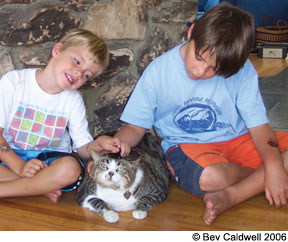How can you possibly go on living without your cat – the handsome, high-spirited, athletic, comically engaging and well behaved little fellow with whom youve shared your home and many of your waking hours for the past 10 or 15 years?

288
That, or a version of it, is among the many challenging and possibly unanswerable questions that loving and conscientious cat owners must ponder when their veterinarians suggest that they might want to consider euthanasia.
The Good Death
Euthanasia techniques, the report goes on, “should result in rapid loss of consciousness followed by cardiac or respiratory arrest and the ultimate loss of brain function. In addition, the technique should minimize distress and anxiety experienced by the animal prior to loss of consciousness.”
“All cat owners should know the facts about euthanasia, which is a very complicated issue,” says James Richards, DVM, director of Cornell Universitys Feline Health Center and the editor-in-chief of CatWatch. “We all want to spare our animals as much suffering as possible, and in situations where a cat is seriously ill and in pain and weve run out of treatment alternatives, the euthanasia option can be very helpful. But its always both a blessing and a curse – a blessing that we can do it in order to relieve an animals suffering, but at the same time a curse in that we have to make the decision.”
The Preliminaries
In most cases, however, there is a sound and genuinely humane reason for considering the procedure. The cat may have a chronic, progressive, recurrent disease for which all treatment options have been exhausted. It may be experiencing end-stage organ failure that, after an indefinite period of pain and suffering, will inevitably be fatal. It has developed a neurologic condition that makes it extremely difficult to care for. Or it has been hit by a car and injured beyond repair.
Although a veterinarian may point out that an injury or disease condition would justify euthanasia, the owners authorization for the procedure is always required. (Dr. Richards advises that cats should always be microchipped or wearing ID tags so that their owners can be reached in case the animal does wander away from home and suffer a life-threatening accident.)
After signing the authorization, the owner can usually elect whether to be present during the procedure, to view the cats remains afterward or to bid farewell to the animal before the procedure is begun. “I always prefer to offer owners as many options as possible in this difficult situation,” says Dr. Richards. “If they want to be present during the procedure, I have no problem with that.
“If there are children involved, I strongly suggest that parents discuss it with them beforehand. Avoid using euphemisms such as putting to sleep, because such terms can be very confusing to youngsters. If you let them know exactly whats going on and why, then its fine if the whole family is present. Unless a severely traumatized animal is involved, euthanasia is almost always an elective procedure, so the family can prepare for it together several days ahead of time.”
Also prior to the procedure, owners are usually asked about disposition of the animals remains. The owners may want to take the euthanized animals body home with them and personally see to its cremation or burial, or they may choose to have the veterinary clinic make the arrangements. Either way, if cremation is chosen, owners may opt to have the ashes returned to them if they so desire.
The Procedure
The drug overdose will quickly cause the animals heartbeat to slow down and stop. Its blood circulation will cease, its brain will stop functioning and it will stop breathing.
“In virtually all cases, the little guy will lose consciousness and simply drift peacefully and painlessly away within a very short time, a matter of seconds,” says Dr. Richards.
Concluding Business
Regarding the payment of fees by grieving owners for a euthanasia procedure, Dr. Richards says: “Although the procedure itself is reasonably priced, it cannot be done for free. But veterinarians will also try to handle this in as sensitive a way as possible on the day of the procedure.”
An informal survey of veterinary clinics suggests that the euthanasia procedure itself will cost about $50. What is termed “common cremation” – with ashes not returned to the owner – will range in price from $25 to $30, depending on the animals size; and cremation with the ashes returned to the owner may range from $100 to $170, depending in some cases on the animals size.
Advice to Owners
“To come to a decision regarding euthanasia,” Dr. Richards writes, “you might ask your veterinarian some of the following questions:
l Can you tell me if my cat is suffering?
l What kinds of treatments are available? What would the cost be?
l What might treatment accomplish? Can I expect a cure, alleviation of pain or prolongation of life?
l What kind of care will I need to provide at home?
Some Questions to Ask Yourself
l What is my cats quality of life?
l Is he comfortable and happy? With treatment, will his quality of life improve or worsen?
l How much longer can I reasonably expect my cat to live?”
If you decide that euthanasia is the best path to take for your beloved pet, Dr. Richards advises, keep the following in mind:
“The death of a beloved cat is never easy. Grief, regret, anger, uncertainty, terrible sadness and/or a feeling of emptiness may accompany the loss. But remember that it is important to allow yourself time to grieve….
“A new cat will not replace your deceased pet in your affections or your heart but can help ease the pain of the loss. A new cat will bring laughter and companionship into your home. When you are ready, there is a cat waiting to share his life with you.”



